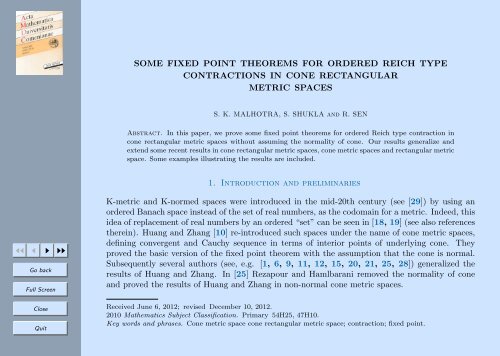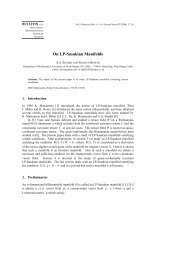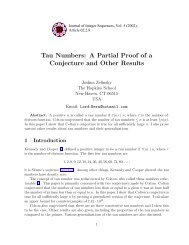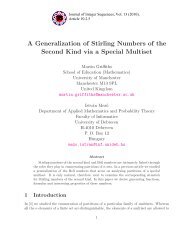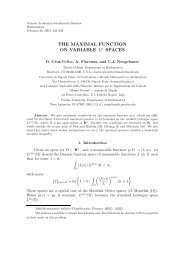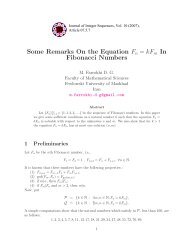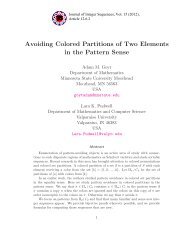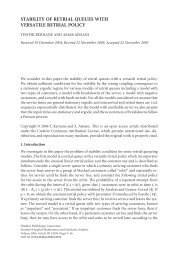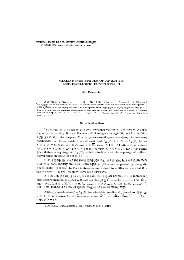SOME FIXED POINT THEOREMS FOR ORDERED REICH TYPE ...
SOME FIXED POINT THEOREMS FOR ORDERED REICH TYPE ...
SOME FIXED POINT THEOREMS FOR ORDERED REICH TYPE ...
You also want an ePaper? Increase the reach of your titles
YUMPU automatically turns print PDFs into web optimized ePapers that Google loves.
<strong>SOME</strong> <strong>FIXED</strong> <strong>POINT</strong> <strong>THEOREMS</strong> <strong>FOR</strong> <strong>ORDERED</strong> <strong>REICH</strong> <strong>TYPE</strong>CONTRACTIONS IN CONE RECTANGULARMETRIC SPACESS. K. MALHOTRA, S. SHUKLA and R. SENAbstract. In this paper, we prove some fixed point theorems for ordered Reich type contraction incone rectangular metric spaces without assuming the normality of cone. Our results generalize andextend some recent results in cone rectangular metric spaces, cone metric spaces and rectangular metricspace. Some examples illustrating the results are included.1. Introduction and preliminaries◭◭ ◭ ◮ ◮◮Go backFull ScreenCloseQuitK-metric and K-normed spaces were introduced in the mid-20th century (see [29]) by using anordered Banach space instead of the set of real numbers, as the codomain for a metric. Indeed, thisidea of replacement of real numbers by an ordered “set” can be seen in [18, 19] (see also referencestherein). Huang and Zhang [10] re-introduced such spaces under the name of cone metric spaces,defining convergent and Cauchy sequence in terms of interior points of underlying cone. Theyproved the basic version of the fixed point theorem with the assumption that the cone is normal.Subsequently several authors (see, e.g. [1, 6, 9, 11, 12, 15, 20, 21, 25, 28]) generalized theresults of Huang and Zhang. In [25] Rezapour and Hamlbarani removed the normality of coneand proved the results of Huang and Zhang in non-normal cone metric spaces.Received June 6, 2012; revised December 10, 2012.2010 Mathematics Subject Classification. Primary 54H25, 47H10.Key words and phrases. Cone metric space cone rectangular metric space; contraction; fixed point.
◭◭ ◭ ◮ ◮◮Go backFull ScreenCloseQuitBranciari [7] introduced a class of generalized metric spaces by replacing triangular inequalityby similar one which involves four or more points instead of three and improves Banach contractionprinciple. Azam and Arshad [4] proved fixed point result for Kannan type contraction inrectangular metric spaces. After the work of Huang and Zhang [10] Azam et al. [5] introduced thenotion of cone rectangular metric space and proved fixed point result for Banach type contractionin cone rectangular space. Samet and Vetro [26] obtained the fixed point results in c-chainablecone rectangular metric spaces.Ordered normed spaces and cones have applications in applied mathematics, for instance, inusing Newton’s approximation method [27] and in optimization theory [8]. The existence of fixedpoint in partially ordered sets was investigated by Ran and Reurings [23] and then by Nieto andLopez [22]. Fixed point results in ordered cone metric spaces were obtained by several authors(see, e.g. [2, 3, 14, 20]).The fixed point results for Reich type mappings and fixed point results for ordered contractionsnot investigated yet even in rectangular metric spaces. In this paper, we extend and generalizethe results of Azam et al. [5] and Azam and Arshad [4] in ordered cone rectangular metric spacesby proving the fixed point theorem for Reich type contractions in the setting of ordered conerectangular metric space. Results in the present paper are the extension and generalization offixed point results of Banach, Kannan [16, 17] and Reich [24] in ordered cone rectangular metricspaces.We need the following definitions and results consistent with [8] and [10].Definition 1 ([10]). Let E be a real Banach space and P be a subset of E. The set P is calleda cone if:(i) P is closed, nonempty and P ≠ {θ}, here θ is the zero vector of E;(ii) a, b ∈ R, a, b ≥ 0, x, y ∈ P ⇒ ax + by ∈ P ;(iii) x ∈ P and −x ∈ P ⇒ x = θ.
◭◭ ◭ ◮ ◮◮Go backFull ScreenCloseQuitGiven a cone P ⊂ E, we define a partial ordering “ ≼ ” with respect to P by x ≼ y if and onlyif y − x ∈ P . We write x ≺ y to indicate that x ≼ y but x ≠ y. While x ≪ y if and only ify − x ∈ P 0 , where P 0 denotes the interior of P .Let P be a cone in a real Banach space E, then P is called normal, if there exists a constantK > 0 such that for all x, y ∈ E,θ ≼ x ≼ y implies ‖x‖ ≤ K‖y‖.The least positive number K satisfying the above inequality is called the normal constant of P .Definition 2 ([10]). Let X be a nonempty set, E be a real Banach space. Suppose that themapping d: X × X → E satisfies(i) θ ≼ d(x, y) for all x, y ∈ X and d(x, y) = θ if and only if x = y;(ii) d(x, y) = d(y, x) for all x, y ∈ X;(iii) d(x, y) ≼ d(x, z) + d(y, z) for all x, y, z ∈ X.Then d is called a cone metric on X and (X, d) is called a cone metric space. In the following wealways suppose that E is a real Banach space, P is a solid cone in E, i.e., P 0 ≠ φ and “ ≼ ” ispartial ordering with respect to P .The concept of cone metric space is more general than that of a metric space, because eachmetric space is a cone metric space with E = R and P = [0, +∞).For examples and basic properties of normal and non-normal cones and cone metric spaces werefer [10] and [25].The following remark will be useful in sequel.Remark 1 ([13]). Let P be a cone in a real Banach space E and a, b, c ∈ P, then(a) If a ≼ b and b ≪ c, then a ≪ c.(b) If a ≪ b and b ≪ c, then a ≪ c.
(c) If θ ≼ u ≪ c for each c ∈ P 0 , then u = θ.(d) If c ∈ P 0 and a n → θ, then there exists n 0 ∈ N such that for all n > n 0 , we have a n ≪ c.(e) If θ ≼ a n ≼ b n for each n and a n → a, b n → b, then a ≼ b.(f) If a ≼ λa where 0 < λ < 1, then a = θ.Definition 3 ([5]). Let X be a nonempty set. Suppose the mapping d: X × X → E, satisfying(i) θ ≼ d(x, y) for all x, y ∈ X and d(x, y) = θ if and only if x = y;(ii) d(x, y) = d(y, x) for all x, y ∈ X;(iii) d(x, y) ≼ d(x, w)+d(w, z)+d(z, y) for all x, y ∈ X and for all distinct points w, z ∈ X−{x, y}[rectangular property].◭◭ ◭ ◮ ◮◮Go backFull ScreenCloseQuitThen d is called a cone rectangular metric on X,, and (X, d) is called a cone rectangular metricspace. Let {x n } be a sequence in (X, d) and x ∈ (X, d). If for every c ∈ E with θ ≪ c there isn 0 ∈ N such that for all n > n 0 , d(x n , x) ≪ c, then {x n } is said to be convergent, {x n } convergesto x and x is the limit of {x n }. We denote this by lim n x n = x or x n → x as n → ∞. If for everyc ∈ E with θ ≪ c there is n 0 ∈ N such that for all n > n 0 and m ∈ N we have d(x n , x n+m ) ≪ c.Then {x n } is called a Cauchy sequence in (X, d). If every Cauchy sequence is convergent in (X, d),then (X, d) is called a complete cone rectangular metric space. If the underlying cone is normal,then (X, d) is called normal cone rectangular metric space.Example 1. Let X = N, E = R 2 and P = {(x, y) : x, y ≥ 0}.Define d: X × X → E as follows:⎧⎨ (0, 0) if x = y,d(x, y) = (3, 9) if x and y are in {1, 2}, x ≠ y,⎩(1, 3) if x and y both can not be at a time in {1, 2}, x ≠ y.
◭◭ ◭ ◮ ◮◮Go backFull ScreenCloseQuitNow (X, d) is a cone rectangular metric space, but (X, d) is not a cone metric space because itlacks the triangular propertyas (3, 9) − (2, 6) = (1, 3) ∈ P .(3, 9) = d(1, 2) > d(1, 3) + d(3, 2) = (1, 3) + (1, 3) = (2, 6)Note that in above example (X, d) is a normal cone rectangular metric space. Following is anexample of non-normal cone rectangular metric space.Example 2. Let X = N, E = CR 1[0, 1] with ‖x‖ = ‖x‖ ∞ + ‖x ′ ‖ ∞ and P = {x ∈ E : x(t) ≥0 for t ∈ [0, 1]}. Then this cone is not normal (see [25]).Define d : X × X → E as follows⎧⎨d(x, y) =⎩0 if x = y,3 e t if x and y are in {1, 2}, x ≠ y,e t if x and y both can not be at a time in {1, 2}, x ≠ y.Then (X, d) is non-normal cone rectangular metric space, but (X, d) is not a cone metric spacebecause it lacks the triangular property.Definition 4. If a nonempty set X is equipped with a partial order “ ⊑ ” and mappingd: X × X → E such that (X, d) is a cone rectangular metric space, then (X, ⊑, d) is called anordered cone rectangular metric space. Let f : X → X be a mapping. The mapping f is callednondecreasing with respect to “ ⊑ ” if for each x, y ∈ X, x ⊑ y implies fx ⊑ fy.A self map f on (X, ⊑, d) is called ordered Banach type contraction if for all x, y ∈ X withx ⊑ y, there exists λ ∈ [0, 1) such that(1)d(fx, fy) ≼ λd(x, y).If (1) is satisfied for all x, y ∈ X, then f is called Banach contraction.
f is called ordered Kannan type contraction if for all x, y ∈ X with x ⊑ y, there exists λ ∈ [0, 1 2 )such that(2)d(fx, fy) ≼ λ[d(x, fx) + d(y, fy)].If (2) is satisfied for all x, y ∈ X, then f is called Kannan contraction.f is called ordered Reich type contraction if for all x, y ∈ X with x ⊑ y, λ, µ, δ ∈ [0, 1) suchthat λ + µ + δ < 1 and(3)d(fx, fy) ≼ λd(x, y) + µd(x, fx) + δd(y, fy).If (3) is satisfied for all x, y ∈ X, then f is called Reich contraction.Kannan showed that the conditions (1) and (2) are independent of each other (see [16, 17])and Reich showed that the condition (3) is a proper generalization of (1) and (2) (see [24]). Notethat Reich type contraction turns into Banach and Kannan type contractions with µ = δ = 0 andλ = 0, µ = δ, respectively.Definition 5. Let X be a nonempty set equipped with partial order “ ⊑ ”. A nonempty subsetA of X is said to be well ordered if every two elements of A are comparable with respect to “ ⊑ ”.Now we can state our main results.◭◭ ◭ ◮ ◮◮Go backFull ScreenCloseQuit2. Main ResultsTheorem 1. Let (X, ⊑, d) be an ordered complete cone rectangular metric space and f : X → Xbe a mapping. Suppose that the following conditions hold(I) f is an ordered Reich type contraction, i.e., it satisfies (3);(II) there exists x 0 ∈ X such that x 0 ⊑ fx 0 ;(III) f is nondecreasing with respect to “ ⊑ ”;(IV) if {x n } is a nondecreasing sequence in X and converging to some z, then x n ⊑ z.
Then f has a fixed point. Furthermore, the set of fixed points of f is well ordered if and only iffixed point of f is unique.Proof. Starting with the given x 0 , we can construct the Picard sequence {x n } as follows. Asx 0 ∈ X is such that x 0 ⊑ fx 0 , suppose fx 0 = x 1 , then x 0 ⊑ x 1 . Again as f is nondecreasing withrespect to “ ⊑ ”, we obtain fx 0 ⊑ fx 1 suppose fx 1 = x 2 . Continuing in this manner, we obtainthe nondecreasing sequence so-called Picard sequence {x n } such thatx 0 ⊑ x 1 ⊑ · · · ⊑ x n ⊑ x n+1 ⊑ · · · and x n+1 = fx n for all n ≥ 0.Note that if x n+1 = x n for any n, then x n is a fixed point of f. So we assume that x n+1 ≠ x n forall n ≥ 0.As x n ⊑ x n+1 , for any n ≥ 0, we obtain from (I)◭◭ ◭ ◮ ◮◮Go backFull ScreenCloseQuitd(x n , x n+1 ) = d(fx n−1 , fx n )≼ λd(x n−1 , x n ) + µd(x n−1 , fx n−1 ) + δd(x n , fx n )= λd(x n−1 , x n ) + µd(x n−1 , x n ) + δd(x n , x n+1 )d(x n , x n+1 ) ≼ λ + µ1 − δ d(x n−1, x n ),i.e., d n ≼ αd n−1 , where α = λ + µ1 − δ and d n = d(x n , x n+1 ).Repeating this process, we obtain that(4)d n ≼ α n d 0 for all n ≥ 1.We can also assume that x 0 is not a periodic point. Indeed, if x 0 = x n for any n ≥ 2, then from(4) it follows that
d(x 0 , fx 0 ) = d(x n , fx n )d(x 0 , x 1 ) = d(x n , x n+1 ),d 0 = d nd 0 ≼ α n d 0 .As α = λ+µ1−δ < 1 (since λ + µ + δ < 1), the above inequality shows that d 0 = θ, i.e., d(x 0 , fx 0 ) = θ,so x 0 is a fixed point of f. Thus we assume that x n ≠ x m for all distinct n, m ∈ N.Again, as x n ⊑ x n+2 , we obtain from (I) and (4)d(x n , x n+2 ) = d(fx n−1 , fx n+1 )≼ λd(x n−1 , x n+1 ) + µd(x n−1 , fx n−1 ) + δd(x n+1 , fx n+1 )= λd(x n−1 , x n+1 ) + µd(x n−1 , x n ) + δd(x n+1 , x n+2 )≼ λ[d(x n−1 , x n ) + d(x n , x n+2 ) + d(x n+2 , x n+1 )] + µd(x n−1 , x n ) + δd(x n+1 , x n+2 )◭◭ ◭ ◮ ◮◮Go backFull ScreenCloseQuitso(5)= λ[d n−1 + d(x n , x n+2 ) + d n+1 ] + µd n−1 + δd n+1= (λ + µ)d n−1 + (λ + δ)d n+1 + λd(x n , x n+2 )≼ (λ + µ)α n−1 d 0 + (λ + δ)α n+1 d 0 + λd(x n , x n+2 )(λ + µ) + (λ + δ)α2d(x n , x n+2 ) ≼ α n−1 d 01 − λ≼ 2λ + µ + δ α n−1 d 0 ,1 − λwhere β = 2λ + µ + δ1 − λd(x n , x n+2 ) ≼ βα n−1 d 0 for all n ≥ 1,≥ 0.
For the sequence {x n } we consider d(x n , x n+p ) in two cases.If p is odd, say 2m + 1, then using rectangular inequality and (4), we obtaind(x n , x n+2m+1 ) ≼ d(x n+2m , x n+2m+1 ) + d(x n+2m−1 , x n+2m ) + d(x n , x n+2m−1 )= d n+2m + d n+2m−1 + d(x n+2m−1 , x n )≼ d n+2m + d n+2m−1 + d n+2m−2 + d n+2m−3 + · · · + d n≼ α n+2m d 0 + α n+2m−1 d 0 + α n+2m−2 d 0 + · · · + α n d 0◭◭ ◭ ◮ ◮◮so(6)= [α 2m + α 2m−1 + · · · + 1]α n d 0 ≼ αn1 − α d 0,d(x n , x n+2m+1 ) ≼αn1 − α d 0.If p is even, say 2m, then using rectangular inequality, (4) and (5), we obtaind(x n , x n+2m ) = d(x n+2m , x n )≼ d(x n+2m , x n+2m−1 ) + d(x n+2m−1 , x n+2m−2 ) + d(x n+2m−2 , x n )= d n+2m−1 + d n+2m−2 + d(x n+2m−2 , x n )≼ d n+2m−1 + d n+2m−2 + d n+2m−3 + d n+2m−4 + . . . + d n+2 + d(x n+2 , x n )Go backFull ScreenCloseQuitso(7)≼ α n+2m−1 d 0 +α n+2m−2 d 0 +α n+2m−3 d 0 +· · ·+α n+2 d 0 + βα n−1 d 0= [α 2m−1 + α 2m−2 + · · · + α 2 ]α n d 0 + βα n−1 d 0 ≼ αn1 − α d 0 + βα n−1 d 0d(x n , x n+2m ) ≼αn1 − α d 0 + βα n−1 d 0 .
◭◭ ◭ ◮ ◮◮Go backFull ScreenCloseQuitAs β ≥ 0, 0 ≤ α < 1, it follows thatαn1−α d 0 → θ, βα n−1 d 0 → θ, so by (a) and (d) of Remark 1,for every c ∈ E with θ ≪ c, there exists n 0 ∈ N such that d(x n , x n+2m ) ≪ c, d(x n , x n+2m+1 ) ≪ cfor all n > n 0 . Thus, {x n } is a Cauchy sequence in X. Since X is complete, so there exists u ∈ Xsuch thatlim x n = lim fx n−1 = un→∞ n→∞We shall show that u is a fixed point of f. By (IV), we have x n ⊑ u, therefore, it follows from (I)thatd(fx n−1 , fu) ≼ λd(x n−1 , u) + µd(x n−1 , fx n−1 ) + δd(u, fu)d(x n , fu) ≼ λd(x n−1 , u) + µd(x n−1 , x n ) + δ[d(u, x n+1 )+ d(x n+1 , x n ) + d(x n , fu)](1 − δ)d(x n , fu) ≼ λd(x n−1 , u) + δd(x n+1 , u) + µd n−1 + δd n .In view of (4) and the fact that 1 − δ ≥ 0, by (d) of Remark 1, there exists n 1 ∈ N such that forevery c ∈ E with θ ≪ c, d n−1 ≪ (1−δ)4µ c and d n ≪ (1−δ)4δc for all n > n 1 . Also x n → u, so thereexists n 2 ∈ N such that for every c ∈ E with θ ≪ c, d(x n−1 , u) ≪ (1−δ)4λc and d(x n+1, u) ≪ (1−δ)4δcfor all n > n 2 .Thus, we can choose n 3 ∈ N such that(8)Again by rectangular inequality,d(x n , fu) ≪ c for all n > n 3 .d(fu, u) ≼ d(fu, x n ) + d(x n , x n+1 ) + d(x n+1 , u)= d(fu, x n ) + d n + d(x n+1 , u).In view of (8),(4) and the fact that x n → u by (c) of Remark 1, we conclude that d(fu, u) = θ,i.e., fu = u. Thus, u is fixed point of f.
Suppose that the set of fixed points A (say) of f is well ordered. We shall prove that u is uniquefixed point of f.Let v ∈ A be another fixed point of f, i.e., fv = v. As A is well ordered, let, e.g., u ⊑ v. From(I) we obtaind(u, v) = d(fu, fv)≼ λd(u, v) + µd(u, fu) + λd(v, fv)= λd(u, v) + µd(u, u) + λd(v, v)= λd(u, v).As 0 ≤ λ < 1, it follows from above inequality and (f) of Remark 1 that u = v. Thus, fixed pointof f is unique. Conversely, if fixed point of f is unique, then A is a singleton set, therefore wellordered.□Taking suitable values of λ, µ, δ in theorem 1, one can obtain following fixed point result inordered cone rectangular metric spaces.◭◭ ◭ ◮ ◮◮Go backFull ScreenCloseQuitCorollary 1. Let (X, ⊑, d) be an ordered complete cone rectangular metric space and f : X → Xbe a mapping. Suppose that following conditions hold:(I) f is(a) an ordered Banach type contraction, or(b) an ordered Kannan type contraction;(II) there exists x 0 ∈ X such that x 0 ⊑ fx 0 ;(III) f is nondecreasing with respect to ⊑;(IV) if {x n } is a nondecreasing sequence in X and converging to some z, then x n ⊑ z.Then f has a fixed point in X. Furthermore, the set of fixed points of f is well ordered if and onlyif fixed point of f is unique.
Remark 2. The above corollary is a generalization and extension of results of Azam et al. [5]and Azam and Arshad [4] in ordered cone rectangular metric spaces in view of used contractiveconditions and normality of cone.Following is an example of ordered Reich type contraction which is not a Reich contraction (inthe sense of [24]) in cone rectangular metric space.Example 3. Let X = {1, 2, 3, 4} and E = C 1 R [0, 1] with ‖x‖ = ‖x‖ ∞ + ‖x ′ ‖ ∞ , P = {x(t) :x(t) ≥ 0 for t ∈ [0, 1]}. Define d: X × X → E as followsd(1, 2) = d(2, 1) = 3 e t ,d(2, 3) = d(3, 2) = d(1, 3) = d(3, 1) = e t ,d(1, 4) = d(4, 1) = d(2, 4) = d(4, 2) = d(3, 4) = d(4, 3) = 4 e t ,d(x, y) = θ if x = y.Then (X, d) is a complete non-normal cone rectangular metric space, but not cone metric space.Define mappings f : X → X and partial order on X as follows:f1 = 1, f2 = 1, f3 = 4, f4 = 2,◭◭ ◭ ◮ ◮◮Go backFull ScreenCloseQuitand ⊑= {(1, 1), (2, 2), (3, 3), (4, 4), (1, 2), (2, 4), (1, 4)}.Then it is easy to verify that f is ordered Reich contraction in (X, ⊑, d) with λ = δ = 3 8 , µ = 1 5 .Indeed, we have to check the validity of (3) only for (x, y) = (1, 2), (2, 4), (1, 4).If (x, y) = (1, 2), thend(f1, f2) = d(1, 1) = θ,therefore, (3) holds for arbitrary λ, µ, δ ∈ [0, 1) such that λ + µ + δ < 1.If (x, y) = (2, 4), thend(f2, f4) = d(1, 2) = 3 e t
◭◭ ◭ ◮ ◮◮Go backFull ScreenCloseQuitandλd(2, 4) + µd(2, f2) + δd(4, f4) = 4λe t + 3µ e t +4δ e t ,therefore, (3) holds for λ = δ = 3 8 , µ = 1 5 .Similarly, (3) holds for (x, y) = (1, 4) with same values of λ, µ, δ. All other conditions of Theorem1 are satisfied and f has unique fixed point, namely “1”.On the other hand, f is not a Reich type contraction in cone rectangular space (non-ordered),e.g., for x = 3, y = 1 d(f3, f1) = d(4, 1) = 4 e t and λd(3, 1) + µd(3, f3) + δd(1, f1) = λ e t +4µ e tand λ + µ + δ < 1, therefore, (3) can not hold.Following example illustrates that fixed point in above results may not be unique (when the setof fixed point is not well ordered).Example 4. Let X = {1, 2, 3, 4}, E = R 2 and P = {(x, y) : x, y ≥ 0}. Define d: X × X → Eas follows:d(1, 2) = d(2, 1) = (3, 6),d(2, 3) = d(3, 2) = d(1, 3) = d(3, 1) = (1, 2),d(1, 4) = d(4, 1) = d(2, 4) = d(4, 2) = d(3, 4) = d(4, 3) = (2, 4),d(x, y) = θ if x = y.Then (X, d) is a complete cone rectangular metric space but not cone metric space. Define f : X →X and partial order on X as follows:⎧⎨fx =⎩x if x ∈ {1, 3},4 if x = 2,1 if x = 4,and ⊑= {(1, 1), (2, 2), (3, 3), (4, 4), (1, 2), (1, 4)}.Then it is easy to see that d(fx, fy) ≼ λd(x, y) for all x, y ∈ X with x ⊑ y, is satisfied forλ ∈ [ 2 3, 1). Thus, f is an ordered Banach contraction on X. All other conditions of Corollary 1
(except the set of fixed points of f is well ordered) are satisfied and f has two fixed points 1 and3 in X. Note that (1, 3), (3, 1) ∉ ⊑ .On the other hand, for x = 1, y = 3, there is no λ such that 0 ≤ λ < 1 and d(fx, fy) ≼ λd(x, y).Therefore, f is not a Banach contraction on X.In the following theorem the conditions on f, “nondecreasing” and completeness of space, arereplaced by another condition.Theorem 2. Let (X, ⊑, d) be an ordered cone rectangular metric space and f : X → X be amapping. Suppose that following conditions hold:(I) f is an ordered Reich type contraction, i.e., it satisfies (3);(II) there exists u ∈ X such that u ⊑ fu and d(u, fu) ≼ d(x, fx) for all x ∈ X.Then f has a fixed point. Furthermore, the set of fixed points of f is well ordered if and only iffixed point of f is unique.◭◭ ◭ ◮ ◮◮Go backFull ScreenCloseQuitProof. Let F (x) = d(x, fx) for all x ∈ X and z = fu, then F (u) ≼ F (x) for all x ∈ X. IfF (u) = θ, then u is a fixed point of f. If θ ≺ F (u), then by assumption (II) u ⊑ fu, so u ⊑ z andby (I), we obtainF (z) = d(z, fz) = d(fu, fz)≼ λd(u, z) + µd(u, fu) + δd(z, fz)= λd(u, fu) + µd(u, fu) + δd(z, fz)= λF (u) + µF (u) + δF (z)F (z) ≼ λ + µ F (u) ≺ F (u) (as λ + µ + δ < 1),1 − δa contradiction. Therefore, we have F (u) = θ, i.e., fu = u. Thus, u is a fixed point of f.
The necessary and sufficient condition for uniqueness of fixed point follows from a similar processas used in Theorem 1.□◭◭ ◭ ◮ ◮◮Go backFull ScreenCloseQuit1. Abbas M. and Jungck G., Common fixed point results for non commuting mappings without continuity in Conemetric spaces, J. Math. Anal. Appl. 341 (2008), 416–420.2. Altun I. and Damnjanović B. and Djorić D., Fixed point and common fixed point theorems on ordered conemetric spaces, Appl. Math. Lett., (2009), doi:10.1016/j.aml.2009.09.016.3. Altun I. and Durmaz G., Some fixed point theorems on ordered cone metric spaces, Rend. Circ. Mat. Palermo,58 (2009), 319–325.4. Azam A. and Arshad M., Kannan fixed point theorem on generalized metric spaces, The Journal of NonlinearScience and its Applications, 1 (2008), 45–48.5. Azam A. and Arshad M. and Beg I., Banach contraction principle in cone rectangular metric spaces, Appl.Anal. Discrete Math., 3 (2009), 236–241.6. Di Bari C. and Vetro P., Weakly ϕ-pairs and common fixed points in cone metric spaces, Rend. Circ. Mat.Palermo, 58 (2009), 125–132.7. Branciari A., A fixed point theorem of Banach-Caccippoli type on a class of generalized metric spaces, Publ.Math. Debrecen, 57 (2000), 31–37.8. Deimling K., Nonlinear Functional Analysis, Springer-Verlag, 1985.9. Wei-Shih Du, A note on cone metric fixed point theory and its equivalence, Nonlinear Anal. 72 (2010), 2259–2261.10. Huang L. G. and Zhang X., Cone metric spaces and fixed point theorems of contractive mappings, J. Math.Anal. Appl. 332 (2007), 1468–1476.11. Ilic D. and Rakocevic V., Quasi-contraction on a cone metric space, Appl. Math. Lett. 22 (2009), 728–731.12. Janković S., Kadelburg Z. and Radenović S., On cone metric spaces: A survey, Nonlinear Anal. 74 (2011),2591–2601.13. Jungck G., Radenović S., Radojević S. and Rakočević V., Common fixed point theorems for weakly compatiblepairs on cone metric spaces, Fixed Point Theory Appl. 57 (2009), ID 643840, 13 pages
◭◭ ◭ ◮ ◮◮Go backFull ScreenClose14. Kadelburg Z., Pavlović M. and Radenović S., Common fixed point theorems for ordered contractions andquasicontractions in ordered cone metric spaces, Comput. Math. Appl. 59 (2010), 3148–3159.15. , A note on the equivalence of some metric and cone metric fixed point results, Appl. Math. Lett. 24(2011), 370–374.16. Kannan R., Some results on fixed point, Bull. Calcutta Math. Soc. 60 (1968), 71–76.17. , Some results on fixed point-II, Amer. Math. Monthly 76 (1969), 405–408.18. Kurepa D. R., Tableaux ramifiés d’ensembles. Espaces pseudo-distanciés, C. R. Acad. Sci. Paris 198 (1934),1563–1565.19. , Free power or width of some kinds of mathematical structure, Publications De L’InstituteMathématique Nouvelle Série tone 42 (1987), 3–12.20. Malhotra S. K., Shukla S. and Sen R., A generalization of Banach contraction principle in ordered cone metricspaces, J. Adv. Math. Stud. 5(2) (2012), 59–67.21. Malhotra S. K., Shukla S. and Sen R., Some coincidence and common fixed point theorems in cone metricspaces, Bulletin of Mathematical Analysis and Applications 4(2) (2012), 64–71.22. Nieto J. J. and Lopez R. R., Contractive mapping theorems in partially ordered sets and applications to ordinarydifferential equation, Order (2005), 223–239.23. Ran A. C. M. and Reurings M. C. B., A fixed point theorem in partially ordered sets and some application tomatrix equations, Proc. Amer. Math. Sco. 132 (2004), 1435–1443.24. Reich S., Some remarks concerning contraction mappings, Canad. Nth. Bull. 14 (1971), 121–124.25. Rezapour Sh. and Hamlbarani R., Some notes on the paper Cone metric spaces and fixed point theorems ofcontractive mappings, Math. Anal. Appl. 345 (2008), 719–724.26. Samet B. and Vetro C., A fixed point theorem for uniformly locally contractive mappings in a c-chainable conerectangular metric space, Surveys in Mathematics and its Applications 6 (2011), 107–116.27. Vandergraft J. S., Newton method for convex operators in partially ordered spaces, SIAM J. Numer. Anal. 4(3)(1967), 406–432.28. Vetro P., Common fixed points in cone metric spaces, Rendiconti Del Circolo Matematico Di Palermo, SeriesII LVI (2009), 464–468.29. Zabreǐko P. P., K-metric and K-normed spaces: survey, Collect. Math. 48 (1997), 825–859.Quit
S. K. Malhotra, Dept. of Mathematics, Govt. S.G.S.P.G. College Ganj Basoda, Distt Vidisha (M.P.) India., e-mail:please refillS. Shukla, Dept. of Appl. Mathematics, Shri Vaishnav Institute of Technology and Science, Indore (M.P.), India,e-mail: satishmathematics@yahoo.co.inR. Sen, Dept. of Appl. Mathematics, Shri Vaishnav Institute of Technology and Science, Indore (M.P.), India,e-mail: please refill◭◭ ◭ ◮ ◮◮Go backFull ScreenCloseQuit


